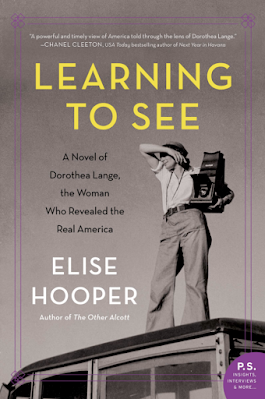 |
| Read an Excerpt |
 |
| Migrant Mother (1936) Credit: Dorothea Lange/Public Domain |
You have heard the photographer's name. Dorothea Lange. But how many of us know the backstory of how Dorothea Margaretta Nutzhorn Lange (1895-1965) became one of the most famous documentary photographers of all time?
 |
| Dorothea Lange (1936) Credit: The Library of Congress/No Restrictions |
Learning to See is historical fiction that reads like an organic biography. Elise Hooper used volumes of historical records and interviews to create this compelling memoir-like novel. Like many based-on-true-life stories, the fiction morphs with the nonfiction into a very realistic portrait of the complex life and times of Dorothea Lange.
We are first introduced to the intrepid twenty-two-year-old Nutzhorn as she arrives in the bohemian San Francisco of 1918. Having been the victim of a thief who makes off with her life savings, Dorothea must use her wits to secure housing and a job as a photographic assistant. Before long, the renamed Lange decides to forge her own path as an independent studio photographer.
As things unfold, we discover Dorothea's many evolving iterations: friend, businesswoman, wife, mother, and fearless social activist. There are elements of Lange's life that some will find upsetting (like choosing to foster out her children during the hard economic times of the Great Depression). The sacrifices endured for the sake of Lange's calling will have lifelong ramifications.
This is a book for those who appreciate historical fiction, biographies, defining moments in time, photography, or reflections on the human landscape of America. I couldn't help but see the parallels between the subjects of Lange's Depression Era portraits and those that are beginning to define this current time of economic collapse, migrant oppression, and social injustice.
As a photographer with a connection to our country's unseen and often marginalized individuals, the themes of this book deeply resonate. For me, Lange's unvarnished look at the real America took me to a place deep within myself that wishes to compassionately acknowledge and respond to the pain of those who are struggling mightily. We know there are multitudes experiencing the hardest times of their lives at this very moment in our nation's history.
 |
| Woman of the High Plains (1938) Credit: Dorothea Lange/Public Domain |
I highly recommend this novel and encourage members of book clubs to consider Learning to See as a group selection. It is sure to generate the kinds of conversations that matter.









































































